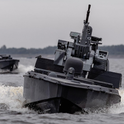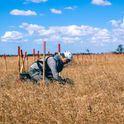“Have a lovely and peaceful day”, says a woman in a little corner shop. The shop is crammed with an eclectic collection of items: from tissues and shampoo bottles to sweets and toys. A miniature tank and rocket launcher sit prominently atop a small mound of plastic trucks for kids. The packaging reads in large letters: “ready to attack”. I ask for several candles, pay and hear the shop assistant wish me a peaceful day as I leave.
Peace is hard to come by in a country that is in the tenth year of defending itself from Russian aggression. But there is one place where I find perfect peace, and that is the place I head to from the corner shop.
The Lychakiv Cemetery in the city of Lviv can tell the complex history of this part of Ukraine. All you need to do is walk through the paths between the graves. Old Austrian tombstones, overgrown with ivy, rise elegantly in their dilapidation. Carefully restored graves of Polish dignitaries boast red and white ribbons. A few headstones without crosses stand over the remains of the Soviet troops and officials who invaded these lands when they were part of Poland in the first half of the 20th century. One of them belongs to a “Bolshevik who died liberating the peoples of western Ukraine from their Polish lords”, according to the epitaph. A local legend captures the arrival of the Soviets in 1939 through the words of a Lviv-based composer: “We’ve been liberated, and it can’t be helped.”
The recent attempt at “liberation” enforced upon the people of Ukraine resulted in an expansion of the Lychakiv Cemetery. Since Russia’s full-scale invasion, the military part has become too full to fit in the new war dead. The overflow is now accommodated in the adjacent section. The last time I visited, in September 2022, I counted around 100 new graves. This time, I am met by a sea of blue and yellow, now covering half of the large field. Each fresh grave has a Ukrainian flag next to it. There are at least twice as many as I saw in September. It turns out Ukrainians would rather die than be “liberated” by the occupiers again. Unlike in 1939, this time it can be helped, but the cost grows daily.
I walk through the rows between the flags, look at the photos of the dead and read the inscriptions. So many of them had only just entered adulthood before the Russians cut their lives short. Here and there are living bodies. A parent, a fellow soldier, a sibling, a partner. They all assume the same pose: arms folded around the stomach, spine curled up, head bowed low. Some are rocking slightly; others are stiff as stone. These are bodies in pain. The pain is phantom: what hurts only exists in memory. The living body above the grave adopts the pain the body six feet under can no longer feel.
I know that phantom pain intimately. My own body has been a vessel for it for over six years, though mine eases somewhat by my brother’s grave. He’s one of the lucky ones: he is buried in the main part of the military pantheon inside the old cemetery and not in the crowded new field. There’s a bench nearby, and I come and sit here to regain peace, to collect my thoughts and begin to make sense of the senseless violence imposed by Russia on my country.
Since February 2022, the rest of the world has discovered that Ukraine exists
Since my brother was killed in action in 2017, so much has changed. Russia scaled up its “liberation”. It is fighting not only the military, but also terrorising civilians by targeting hospitals, schools, and ordinary family homes as their inhabitants catch some sleep in between air raid sirens. It has left vast areas uninhabitable, by razing cities and towns to the ground; by turning what was once a place into post-apocalyptic territory. Village after village stands empty; forests, littered with mines, are abandoned; fields are wounded with explosions and covered in gaping craters instead of crops. These places have been liberated from life by the Russians and recovery will take years, demining will take decades, and forgiveness will take generations, if it ever comes.
Another thing that has changed, especially since February 2022, is that the rest of the world has discovered that Ukraine exists. It’s strange to start existing for some just as others are doing their worst to ensure that we cease to do so. However, to keep existing, it’s not enough to have been discovered. You need to constantly remind the world that the life of your country matters and thus needs military, political, and financial support. It needs unwavering international solidarity. Ukrainians have been protecting their right to exist for over nine years (that is, if we don’t count earlier imperialist attempts to swallow this nation up over the centuries). They will never tire of fighting for their lives.
But the rest of the world is growing tired of the war after a year of watching it on the news. Journalists have to keep their audiences engaged somehow. One way to do so is to tell identifiable human stories.
For the past 14 months, I’ve been asked many times in the media and in public discussions to provide a “human angle” to Russia’s war. As well as feeling frustration at being pigeonholed into the category of “grieving woman”, I also wonder which part of the war these people consider to be not human. The trenches where soldiers, covered in spring mud, overcome boredom and fear by reading history books or flicking through social media? The war rooms where high officials make decisions on strategy, knowing full well the human cost of their choices? The train stations where couples say their goodbyes, as earth-shattering as any explosion? The cemeteries where the war dead find eternal peace and the living acquire eternal pain? The question is incomprehensible to me because the human angle is found in all aspects of a war that has disturbed all aspects of life. I see it in every encounter and hear it in every conversation I have when I return to Ukraine.
Speaking to my uncle, I ask how his grandson is doing after his father left for the front.
“He’s doing great. He’s got such excellent imagination,” says my uncle. “When he’s not building barricades out of chairs, he’s shooting at the enemy from behind the sofa.”
For a moment, I wonder if I should have bought the “ready to attack” toy for the boy as a present. But there’s so much war in his childhood already that he doesn’t need a plastic tank to play with. He wants his father back, and for that, real tanks are needed. Lots of them.
“Half of my phone book is empty now. The numbers belong to people who no longer live,” says a friend who himself is serving in the armed forces. “I don’t even save anyone’s numbers anymore. I don’t want another entry that won’t answer.”
I have nothing to say to that. So, we drink our tea and watch the kids play. He’s on leave; it’s a rare chance for him to see them. His younger son runs up to him and grabs his military cap. “Can I put it on my head, daddy, pleeease?” he shouts excitedly. “I want to be a soldier like you.”
My friend lets his boy put the military cap on and the little head disappears in the khaki fabric. I pray that this child and his peers feel as little of the phantom pain as possible as they grow into adults.
As I return to my brother’s grave and think about how to finish this piece, I realise that I don’t want to let go of my phantom pain. It reminds me of who I am. And it’s this understanding of self that sustains Ukrainians in this war and that will ensure their victory.
The sun is shining, it’s a lovely day. If only it were peaceful too.












